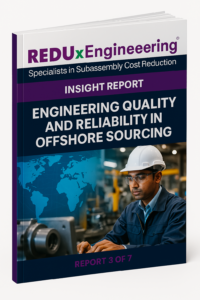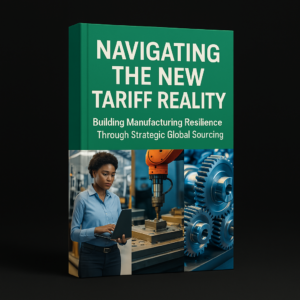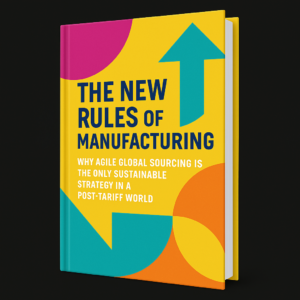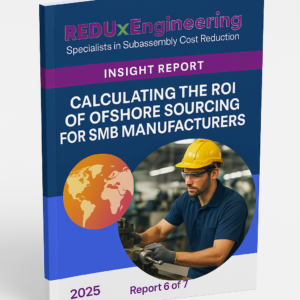
Introduction:
A common concern about offshoring production is, “Will the quality suffer?” or “What about the risks of dealing with distant suppliers?” This report tackles those concerns head-on, explaining how engineering-driven offshoring can actually enhance quality and reliability while delivering cost savings. We outline the best practices that mitigate risk – from vetting suppliers to on-site quality control – and why an engineering approach (as opposed to a pure procurement approach) is crucial. The big idea: with the right processes, offshore manufacturing can meet or exceed the quality standards of domestic production, and sometimes even improve lead times and consistency. The key is rigorous management and technical oversight, which is REDUxEngineering’s core philosophy.
“Quality Fade” Myth vs. Reality:
There’s a persistent myth that anything made overseas (particularly in Asia) is lower quality. While there have been cases in the past of quality issues, the reality today is that top-tier offshore factories are world-class – often holding ISO certifications and supplying demanding industries like automotive and aerospace. In fact, China and Vietnam have built state-of-the-art Industry 4.0 manufacturing complexes for electronics, metals, and plastics. These facilities leverage advanced automation and process controls on par with (or better than) those in Western countries. The capability and modernity at such plants “cannot currently be achieved elsewhere” in some cases. What this means for an SME is that if you partner with a vetted, high-calibre offshore supplier, the inherent quality potential is excellent. Many Western companies have actually seen higher yield and fewer defects after moving to a specialized overseas supplier, because that supplier had better equipment or process expertise than the previous local one. For example, an American company shifting a precision machining job to a renowned Taiwanese CNC firm found that part consistency improved due to the supplier’s advanced in-line inspection systems. The lesson: quality is not about geography, it’s about process and oversight. The best offshore suppliers are fully capable of meeting your specs – provided you choose the right partner.
The Engineering-Driven Approach:
Ensuring quality offshore starts long before production. It begins with engineering due diligence in supplier selection and part preparation. REDUxEngineering follows a methodical vetting process: we only work with suppliers that have proven certifications, quality management systems, and relevant experience. For each project, our Registered Professional Engineers and Six Sigma-certified Supplier Development Engineers assess potential vendors’ capabilities (equipment, skill level, QC processes). This technical vetting goes far deeper than a typical purchasing agent’s price checklist. We often engage in a Design for Manufacturing (DFM) review upfront, adjusting the part design or specifications in collaboration with the supplier to ensure it can be produced reliably. By optimizing tolerances, materials, or process steps, we reduce the chance of quality issues later. This is a key difference: an engineering approach to offshoring means we don’t simply throw the drawing over the fence – we actively refine it and plan out production with quality in mind from the start. Academic research supports this practice, noting that involving engineering in supplier selection and early design phases leads to better outcomes (fewer defects, smoother ramp-up).
On-Site Presence and Audits:
Another critical element is having “eyes and ears” at the factory. REDUxEngineering or similar partners maintain a local presence – we conduct on-site audits before and during production. For instance, before any first article is shipped, our team is physically at the supplier’s facility doing a pre-shipment inspection and process audit. We verify that the parts meet spec before they leave the factory floor. This prevents surprises. By catching any issue at the source, we avoid the nightmare of a container full of defects. Additionally, ongoing periodic audits and quality checks ensure that quality doesn’t drift over time. Many offshore suppliers are extremely open to this (the reputable ones welcome customer oversight). This boots-on-the-ground approach drastically reduces risks like “quality fade” (where a supplier might gradually cut corners). When suppliers know that an engineer will be checking their work regularly, they stay on their toes. It creates a culture of accountability and partnership rather than a distant transactional relationship.
Supplier Development and Training:
In some cases, improving quality offshore means actively investing in the supplier’s capability. For complex or highly specialized products, REDUxEngineering may send process experts to train the supplier’s team or help implement specific quality controls. Think of it as exporting your quality culture. For example, if a supplier in Malaysia is making an electrical cable assembly for you, we might help them establish a more rigorous testing protocol (e.g., hipot and continuity tests on 100% of units) and use statistical process control on crimp dimensions. These kinds of enhancements ensure the final output meets the standards you would enforce in-house. Far from being a hands-off approach, a well-managed offshoring program can extend your own quality system into the supplier’s factory. Academic sources note that companies which treat offshore suppliers as extensions of their production network – sharing know-how and aligning standards – tend to achieve equal or better quality than domestic production.
Risk Mitigation – Beyond Quality:
Quality is one aspect of reliability; another is ensuring steady supply and managing risks like IP protection or geopolitical issues. An engineering-led strategy tends to address these as well. For instance, to protect intellectual property, we might split the supply chain – manufacturing different subcomponents at different suppliers so no single supplier has the full product blueprint. Or we might use contract clauses and on-site oversight to guard against unauthorized reproductions. As for delivery reliability, diversifying sources (having two suppliers in different countries) can provide a fallback if one location faces a disruption. These strategies are part of operational risk management that goes hand-in-hand with offshoring. It’s noteworthy that companies solely reliant on domestic sources are not immune to disruptions – they concentrate risk in one region. A global approach, if properly managed, can actually increase resilience (for example, if a natural disaster or local strike hits your country, an offshore partner in another region can keep supply going). So reliability can improve in terms of continuity of supply and flexibility.
Real-World Proof – Case Example:
To illustrate the above, consider a North American hardware manufacturer that needed to offshore a submersible control cable assembly (a product requiring strict quality for underwater use). They were understandably nervous about quality. REDUxEngineering guided the project: we selected a supplier in Vietnam with a strong track record in cable assemblies, helped them source a durable overmold material, and set up a testing regimen (every cable 100% electrically tested and pressure-tested for leaks). We stationed an inspector on-site for the first production runs. The result: the offshore-made cable assemblies not only met all specifications, but had zero failures in field testing – outperforming the previous domestic batches that had a small percentage of leakage issues. This client’s fear of offshore quality turned into an appreciation that, with the right controls, the offshore product was as good or better.
Conclusion:
Quality need not be sacrificed on the altar of cost savings. By taking an engineering-first approach to offshoring, a company can enjoy the best of both worlds: significant cost reductions and high quality. Key takeaways include the importance of vetting and choosing the right suppliers, engaging in DFM and technical collaboration upfront, maintaining a presence for quality assurance (inspections/audits), and integrating the offshore partner into your quality system and culture. When done correctly, offshoring can actually enhance reliability – for instance, leveraging a supplier’s specialized expertise or superior equipment might improve consistency. The notion that “made locally is inherently better” is outdated; what matters is “made with the proper process control and oversight.” In the next report, we will see how these principles help in the specific context of navigating new tariffs and trade disruptions – effectively turning global sourcing into a risk mitigation strategy, not a liability.
References (Report 3):
- REDUx Engineering Website – “The REDUx Advantage”. Describes on-site audits: parts are checked before they leave the factory. Emphasizes pre-vetted partner network and engineering-driven process (no compromise on quality).
- REDUx Engineering LinkedIn Post (2024) – Case study of Submersible Cable Assembly. Achieved first-pass success by implementing robust testing and on-site oversight, highlighting how offshored product met strict quality requirements.
- Tapecon Manufacturing Blog (2021) – “7 Benefits of Outsourced Manufacturing”. Notes that giving up internal control is mitigated by vetting partners; reputable partners have proven Quality Management Systems (ISO, etc.) in place. Also discusses how outsourcing frees up focus on core tasks – relevant to quality in that internal teams can concentrate on design improvements while the partner handles production quality.
- Thunder Said Energy (2025) – Observation that modern Industry 4.0 facilities in China/Vietnam deliver sophistication and quality not easily matched elsewhere. Supports the point that offshore does not equate to inferior quality – often the opposite when using top-tier suppliers.
- Academic Source – Kotabe et al. (2008), via Dpublication.com: Offshoring is a source of cost savings and a way to acquire know-how (cited in search result [84]). Implies that working with specialized offshore suppliers can enhance a firm’s knowledge and quality practices.
#OffshoreQuality #EngineeringDriven #GlobalManufacturing #SupplierVetting #DFM #QualityControl #REDUxEngineering #ManufacturingExcellence #OperationalResilience #Industry40






